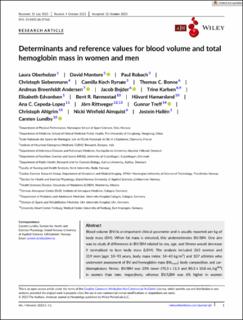| dc.contributor.author | Oberholzer, Laura | |
| dc.contributor.author | Montero, David | |
| dc.contributor.author | Robach, Paul | |
| dc.contributor.author | Siebenmann, Christoph | |
| dc.contributor.author | Ryrsøe, Camilla Koch | |
| dc.contributor.author | Bonne, Thomas C. | |
| dc.contributor.author | Breenfeldt Andersen, Andreas | |
| dc.contributor.author | Bejder, Jacob | |
| dc.contributor.author | Karlsen, Trine | |
| dc.contributor.author | Edvardsen, Elisabeth | |
| dc.contributor.author | Rønnestad, Bent | |
| dc.contributor.author | Hamarsland, Håvard | |
| dc.contributor.author | Cepeda-Lopez, Ana C. | |
| dc.contributor.author | Rittweger, Jörn | |
| dc.contributor.author | Treff, Gunnar | |
| dc.contributor.author | Ahlgrim, Christoph | |
| dc.contributor.author | Almquist, Nicki Winfield | |
| dc.contributor.author | Hallén, Jostein | |
| dc.contributor.author | Lundby, Carsten | |
| dc.date.accessioned | 2024-03-19T07:31:37Z | |
| dc.date.available | 2024-03-19T07:31:37Z | |
| dc.date.created | 2023-12-18T12:13:52Z | |
| dc.date.issued | 2023 | |
| dc.identifier.citation | American Journal of Hematology. 2023, 99 (1), 88-98. | en_US |
| dc.identifier.issn | 0361-8609 | |
| dc.identifier.uri | https://hdl.handle.net/11250/3122979 | |
| dc.description.abstract | Blood volume (BV) is an important clinical parameter and is usually reported per kg of body mass (BM). When fat mass is elevated, this underestimates BV/BM. One aim was to study if differences in BV/BM related to sex, age, and fitness would decrease if normalized to lean body mass (LBM). The analysis included 263 women and 319 men (age: 10–93 years, body mass index: 14–41 kg/m2) and 107 athletes who underwent assessment of BV and hemoglobin mass (Hbmass), body composition, and cardiorespiratory fitness. BV/BM was 25% lower (70.3 ± 11.3 and 80.3 ± 10.8 mL/kgBM) in women than men, respectively, whereas BV/LBM was 6% higher in women (110.9 ± 12.5 and 105.3 ± 11.2 mL/kgLBM). Hbmass/BM was 34% lower (8.9 ± 1.4 and 11.5 ± 11.2 g/kgBM) in women than in men, respectively, but only 6% lower (14.0 ± 1.5 and 14.9 ± 1.5 g/kgLBM)/LBM. Age did not affect BV. Athlete's BV/BM was 17.2% higher than non-athletes, but decreased to only 2.5% when normalized to LBM. Of the variables analyzed, LBM was the strongest predictor for BV (R2 = .72, p < .001) and Hbmass (R2 = .81, p < .001). These data may only be valid for BV/Hbmass when assessed by CO re-breathing. Hbmass/LBM could be considered a valuable clinical matrix in medical care aiming to normalize blood homeostasis. | en_US |
| dc.language.iso | eng | en_US |
| dc.publisher | Wiley | en_US |
| dc.rights | Attribution-NonCommercial-NoDerivatives 4.0 Internasjonal | * |
| dc.rights.uri | http://creativecommons.org/licenses/by-nc-nd/4.0/deed.no | * |
| dc.title | Determinants and reference values for blood volume and total hemoglobin mass in women and men | en_US |
| dc.title.alternative | Determinants and reference values for blood volume and total hemoglobin mass in women and men | en_US |
| dc.type | Peer reviewed | en_US |
| dc.type | Journal article | en_US |
| dc.description.version | publishedVersion | en_US |
| dc.source.pagenumber | 88-98 | en_US |
| dc.source.volume | 99 | en_US |
| dc.source.journal | American Journal of Hematology | en_US |
| dc.source.issue | 1 | en_US |
| dc.identifier.doi | 10.1002/ajh.27162 | |
| dc.identifier.cristin | 2214805 | |
| cristin.ispublished | true | |
| cristin.fulltext | original | |
| cristin.qualitycode | 1 | |

